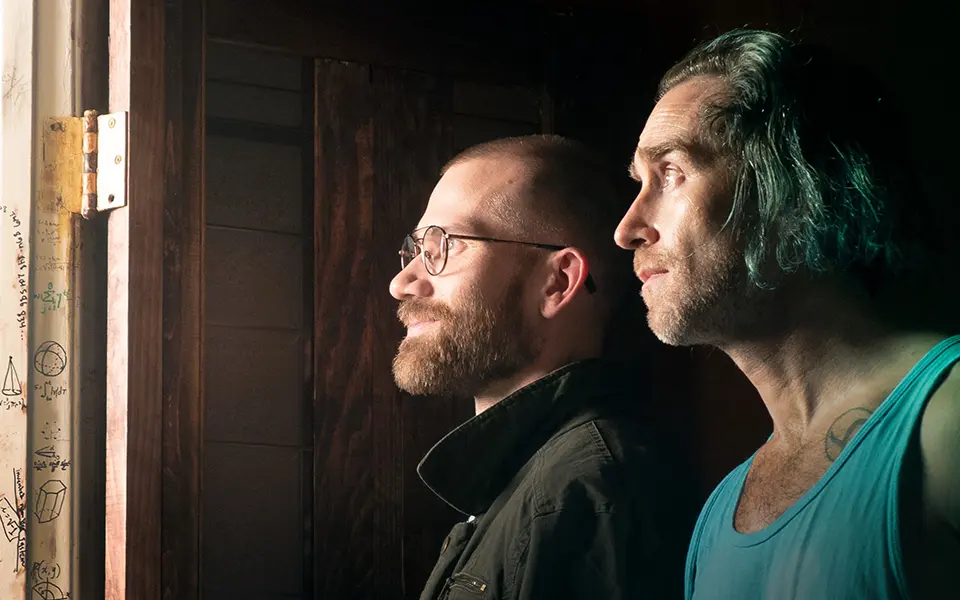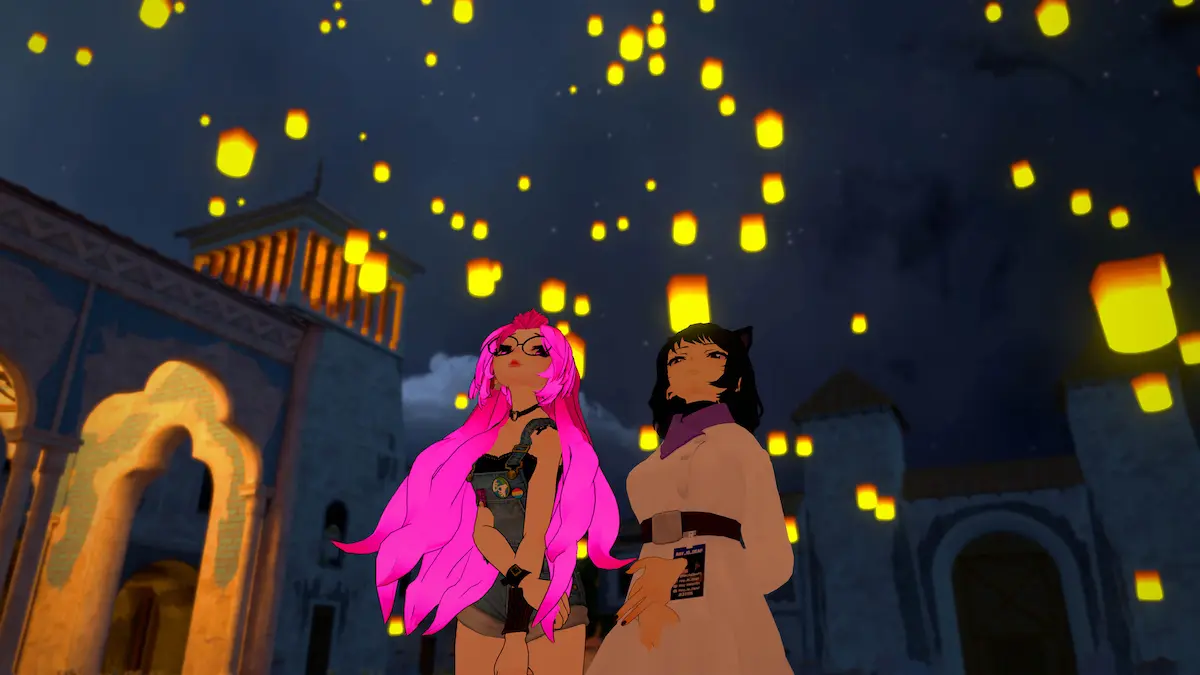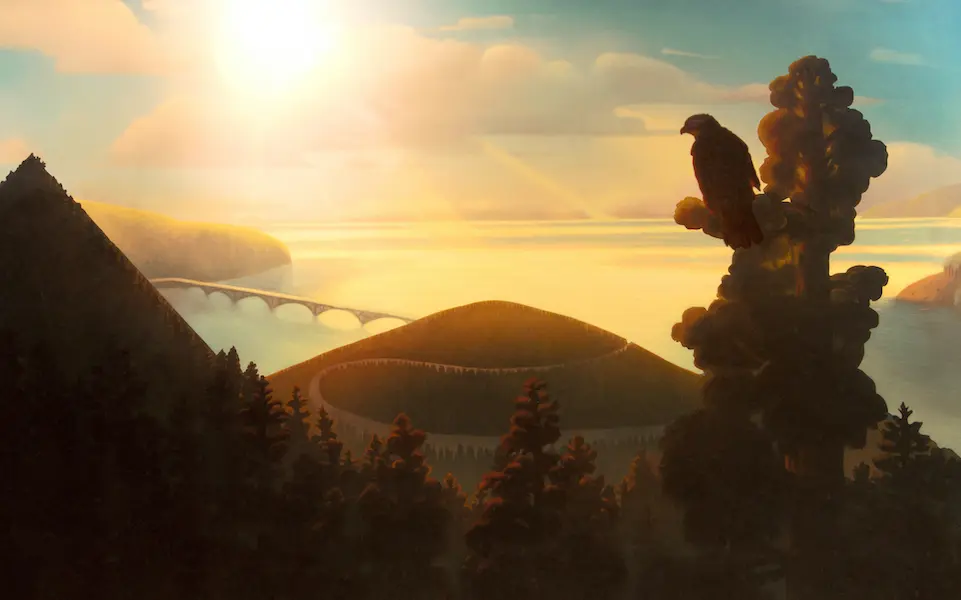
Dropbox for filmmakers, Sundance Film Festival 2022, Creators worth learning from
Directors Justin Benson and Aaron Moorhead on the joy of creating things with friends
Published on January 24, 2022
In the trippy films of indie darlings Justin Benson and Aaron Moorhead, characters often grapple earnestly with things they can’t quite explain: never-ending time loops, lovers who are also mutants, death cults that seem, perhaps…fun? In the case of their latest, Something in the Dirt—which premiered this weekend at the Sundance Film Festival—it’s a crystal ashtray in an L.A. home that one day begins hovering in thin air. Two new neighbors, played by Benson and Moorhead, spiral down a rabbit hole on a search for why.
In many respects, the film is a time capsule of the pandemic. Nearly every scene features just Benson and Moorhead in a humble apartment building—albeit, with stunning supernatural events. “In the cut the Sundance team saw and accepted, these characters would be having an intense argument on camera—and then cut to floating objects clearly just being held by us,” Moorhead says with a laugh. In fact, the duo still haven’t met VFX supervisor Alban Kasikci, who added all the magic remotely and bounced cuts back and forth over Dropbox.
Here, the two friends, along with Kasikci and co-editor Michael Felker, talk about bringing unbelievable things to life, finding your lane as a filmmaker, and why it’s better to create things with people you care about.
~ ~ ~
I love that your work often addresses how people engage with mystery. How do your personal experiences with unknowable things inform that?
Moorhead: I think every single one of our movies is about the same thing: encountering the unexplainable, the larger than oneself. I absolutely love all kinds of movies, but the ones that stay with us ask a question bigger than what the plot is. We’re in a constant spiritual search for answers that we know we're never going to get. Movies are a meditation on that. It's like going to church, even though they're told within this construct of, like, a fun genre film.
Benson: When I was little, I had this night of insomnia—I was like six years old—where I couldn't sleep, because I had just discovered the idea of infinity. What is that? Like, if you keep going up in space, what happens? I talked to my dad. He's having a beer, playing guitar. He’s just like, “Well, there are certain things you’ll never have the answer to. If you desire that answer too much, you’ll end up joining a cult or something so just get comfortable with ‘I don’t know.’” Cut to 20 years later, Aaron and I meet, these friendships form, and we just made like six movies about it.
You often talk about the importance of films made by friends. Some people would say it’s best not to mix business and pleasure.
Moorhead: See, when you make movies with your friends—it’s just not work. It can be hard, it can be challenging, but it’s not like a job where you clock in to make money. It feels like a hobby, like decompression.
Benson: Wait, I’m not just saying this to make a joke. Hungry Dave was just outside the window! [Editor’s note: Hungry Dave is the name of a local squirrel who also stars in the film.]
Wait, was this filmed in your actual apartment?
Benson: That’s literally where we’re at.
Moorhead: So the main place is this apartment, Justin’s apartment. And the office is downstairs where I live. And the hard drive for the movie is actually in the movie, too. And that’s the office we actually edited in.
On that topic, what are the biggest challenges for editing a film like this remotely?
Felker: Honestly, I’ve been a Dropbox guy for almost a decade. It's been the best way for me to handle remote editing but also file sharing and just making sure people are on top of what they need. Dropbox was very pivotal for us remote editing, though.
"We’re in a constant spiritual search for answers that we know we're never going to get. Movies are a meditation on that."
Benson: We were all in very different time zones [across North America and Europe]. But luckily, technology is available to a) share files, b) organize them, and c) communicate with each other.
Moorhead: We used text chains. Whenever someone had something to show, they’d just send a Dropbox link. If someone was awake, they just had to be available to return a message.
Benson: If Aaron and I searched our texts for the word “approve” it would probably occur about 45,000 times.
How did you use Dropbox to pull off all the special effects?
Kasikci: When we looked at the edited version, we had about 200 shots to do, which is a lot. And we had to figure out how to do everything in about six months. Speed was really important but also we had a low margin of error and we put everything in place so quickly—thanks to Dropbox because we needed the space and also a structure for so many files.
What do you want people to feel when they watch Something in the Dirt?
Benson: I hope people feel unease. I hope they feel frightened. But I also hope they experience laughter, joy, levity.
Felker: I hope people do the same thing I did, which is just cackle with delight. When it ends, I’m grinning ear to ear.
Moorhead: I’d say a sense of wonder, a sense of awe—not really at the film but at the things the film is trying to talk about.
"We had a low margin of error and we put everything in place so quickly—thanks to Dropbox because we needed the space and also a structure for so many files."
Justin and Aaron, you’re known for making scrappy and beloved films. What advice do you all have for aspiring screenwriters and filmmakers?
Kasikci: We live in a time where there are so many resources online to educate yourself. Find some friends, people you are ready to spend some time with, and just finish it. Yes, it takes money and resources, but it doesn’t have to be big.
Benson: I’m always increasingly afraid of answering this question, because, yes, our answer is always going to be something along the lines of just grab a camera and go do it. Do something that you have the resources to do. You don't want to conceive of material that's going to require a studio head to green-light it for $100 million. And in our experience, to continuously make things, we've had to do it in a way that was just, like, use the resources you have. But sometimes when someone shows me a script that I can tell is really expensive, I'll be tempted to say, “You know, you should just have something small and personal in your back pocket.” But I also don't want to be the person that gives advice that prevents someone from selling a script for $20 million!
Moorhead: In the end it’s like, well, if you write a big budget thing, you can hope you’ll convince someone as a first-time filmmaker that you can do it. Maybe that’ll happen. And maybe if I buy a lottery ticket, I’ll win the lottery. The advice I’d give is that if you conceive of something that is personal—it doesn't have to be autobiographical, just personal—and it's something you’re extremely interested in, that’s what’s called your voice. And if you’re making something personal within your means, that is how you can turn filmmaking into your job.
This interview has been lightly edited and condensed for clarity.
To learn more about Something in the Dirt and the 2022 Sundance Film Festival, visit festival.sundance.org



